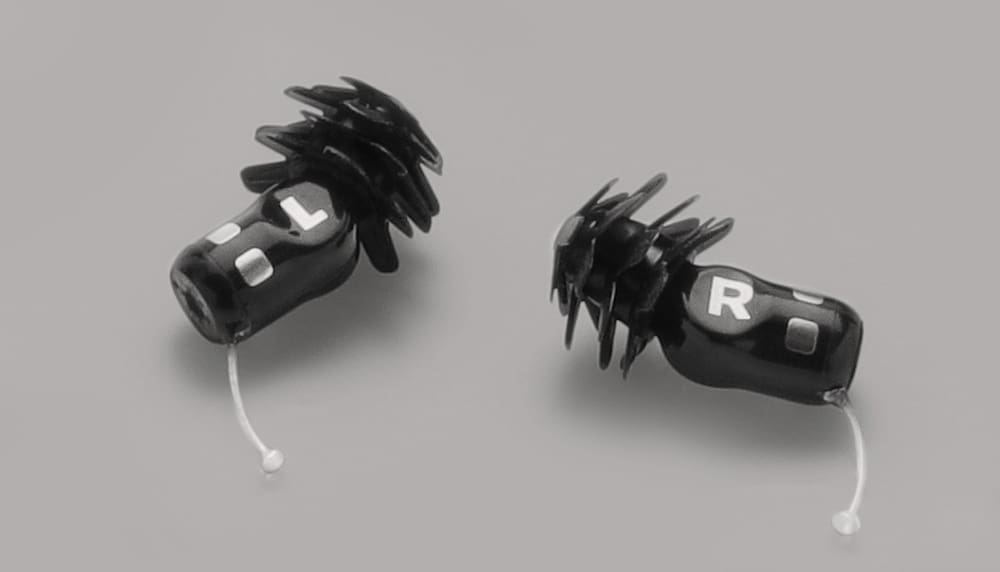
Eargo Hearing Aids Review, Audiologist Reviewed

After extensive testing by our team of audiology experts, we’ve found Eargo hearing aids to be remarkable for their virtually invisible design and user-friendly technology. Priced between $799 to $2,699 per pair, these rechargeable devices excel for those with mild to moderate hearing loss who prioritize discretion. The sophisticated Eargo app allowed us to easily customize sound profiles across various environments, from restaurants to theaters.
While only one model (Eargo LINK) supports Bluetooth streaming, all models feature excellent noise cancellation technology and a comfortable fit. Our hands-on evaluation confirms Eargo offers exceptional value compared to traditional hearing aids, backed by responsive customer support from licensed hearing professionals. On the other hand, if you want to dive deeper into pricing, read our article on Eargo hearing aid costs.
New to the world of hearing aids? Check out our guide to hearing aids to learn about the many different devices available and how they can help those with hearing loss.
Eargo Pros and Cons
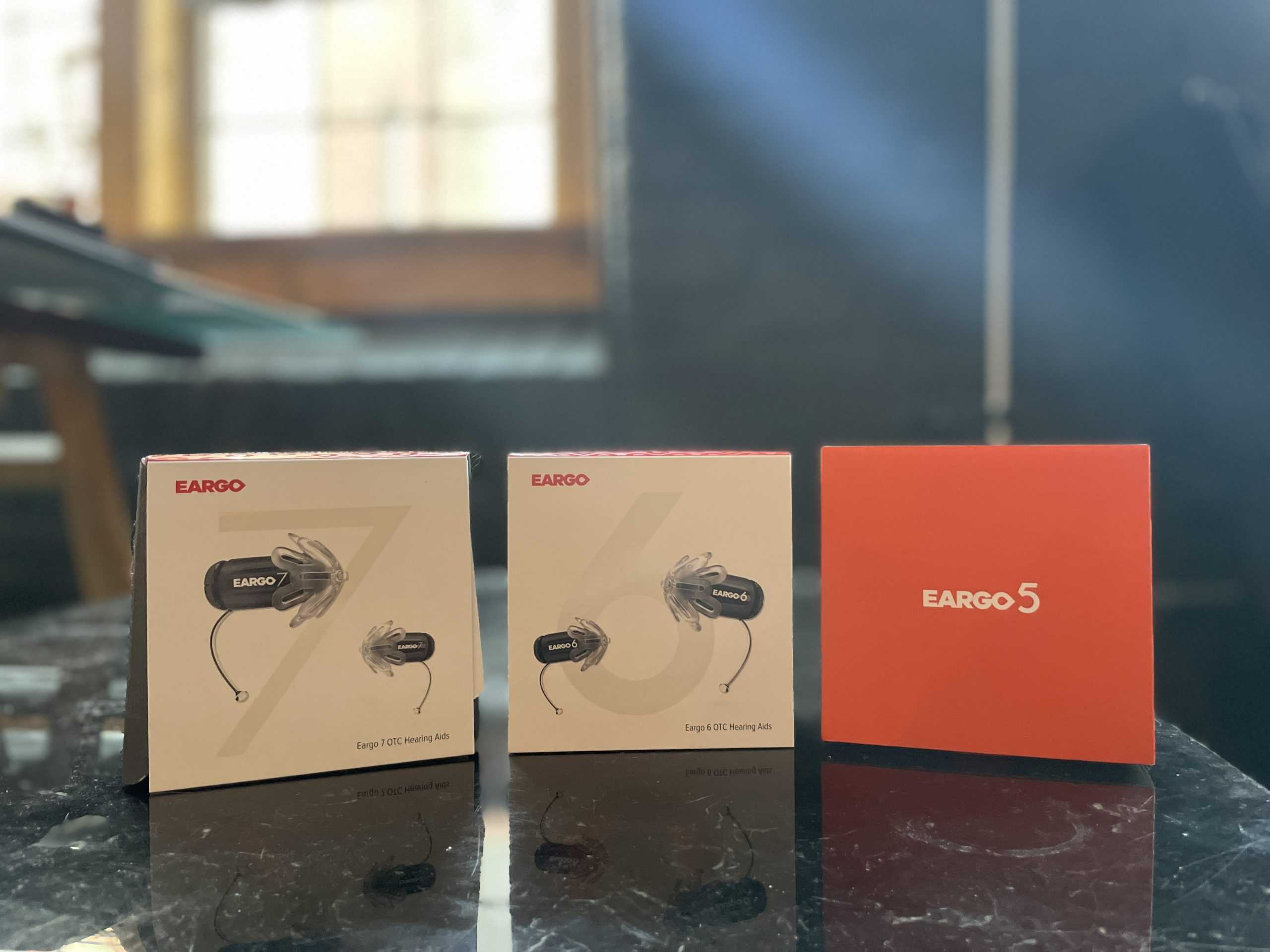
Pros
- Invisible design: Eargo hearing aids fit completely inside your ear canal, making them one of the most discreet models we’ve seen.
- Affordable pricing: With devices costing as low as $799 for a pair, Eargo hearing aids cost less than half the price of traditional hearing aids, which retail for anywhere from $2,000 to $7,000.1
- Rechargeable batteries: If you don’t like carrying replacement batteries, you’ll appreciate the rechargeable batteries on Eargo’s hearing aids. All three models also include a charging case that can store additional power for on-the-go charging.
- Useful smartphone app: The Eargo app allows you to adjust your hearing aids (volume, bass, treble, and sound environments) without removing them from your ears.
Cons
- Limited Bluetooth: Only the LINK supports streaming music and calls from a smartphone.
- No severe hearing loss solutions: All three of Eargo’s models are designed for those with mild to moderate hearing loss. If you have a greater hearing loss, then check out our picks for the best hearing aids for severe hearing loss.
- No battery replacements: Although we appreciate rechargeable hearing aids, they gradually lose their capacity to hold a charge. If this happens after the expiration of your Eargo warranty, then you’ll have to pay for new ones.
Nearly three out of ten U.S. adults ages 65 and over have some or a lot of difficulty hearing, or can’t hear at all.2 Because of this, many are turning to OTC hearing aids, which are much more affordable than prescription devices.
Eargo Hearing Test
Eargo offers a free online hearing test. It consists of a standard hearing screening and questions to help you understand how hearing loss impacts your lifestyle. Hearing loss, more prevalent among adults 65 and older, can “disrupt interpersonal communication” and “interfere with perception of meaningful environmental sounds,” leading to embarrassment, distress, and self-criticism, according to the National Institutes of Health.3
The hearing test works best with in-ear headphones. While you can use traditional over-the-ear headphones, the test produces more accurate results with earbuds. We found that the hearing check was similar to the screening you undergo at an audiologist exam.
Choose a quiet room to undergo the hearing screening. The test requires a “calibration” step to ensure more reliable results. Afterward, the check will play tones of various frequencies to determine the hearing loss in each ear. Once you hear the tone, you press the button to confirm it; then, the test will move on to the next frequency. There are four tones for each ear.
Tip: Once you’ve got your hearing aids, you’ll want to take care of them. Read our guide on how to clean hearing aids to learn more.
After the screening, you must answer a few questions about your age and socialization and television habits. The results gauge your hearing health from “no loss” to “profound” hearing loss; they also determine whether you could benefit from hearing aids. While the test is user-friendly, the results are not very detailed.

Eargo Hearing Aid Models
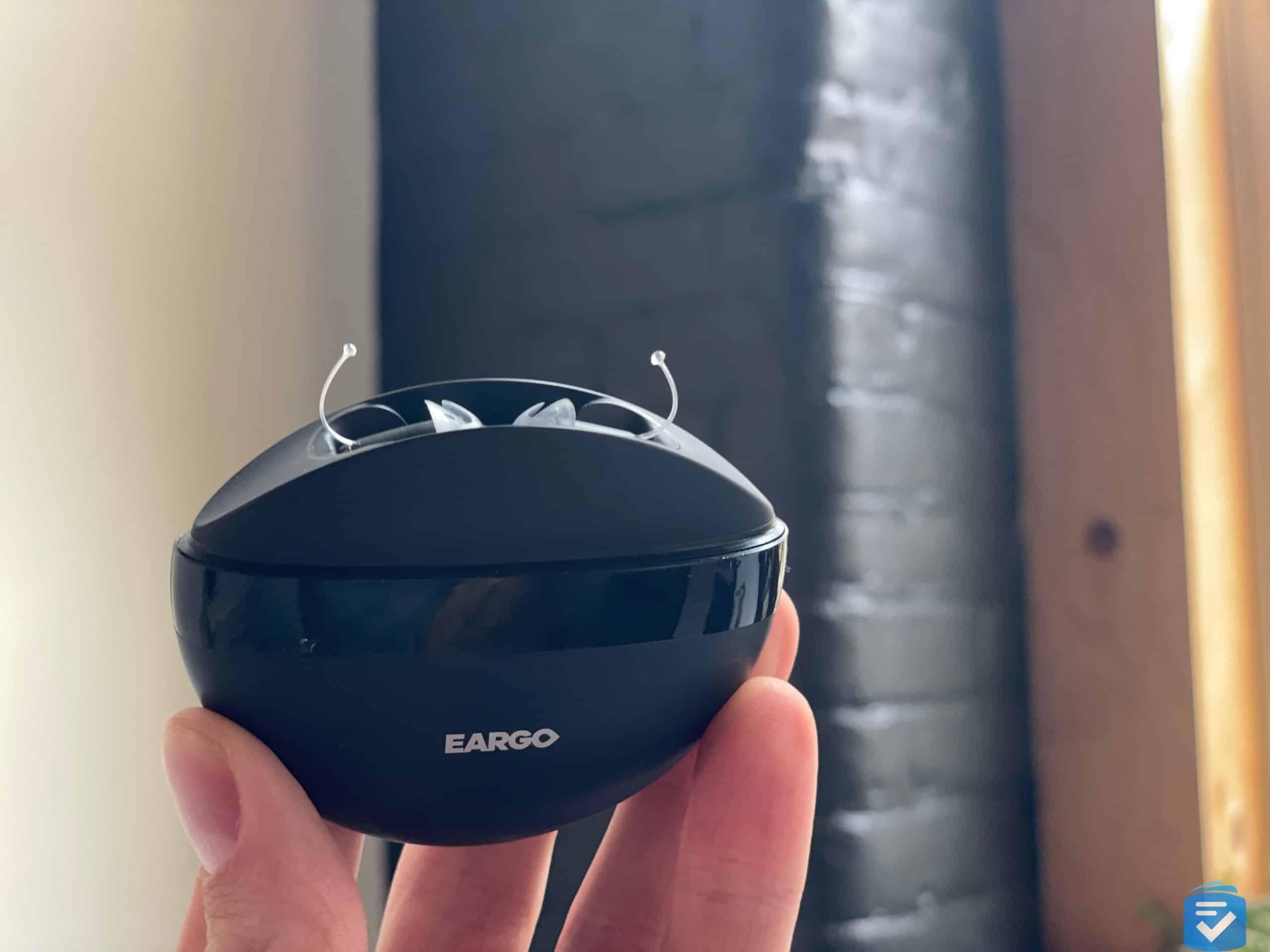
Eargo offers three different models: the LINK by Eargo, Eargo SE, and Eargo 8. The biggest difference between them is the sound quality. The Eargo 8’s Smart Sound Adjust technology will automatically adjust based on your location. For example, when we wore these hearing aids in a crowded restaurant, they recognized and canceled background noise automatically, allowing us to focus on our conversation.
The other major difference will be the Bluetooth streaming available on the LINK. While each Eargo model can pair with a smartphone for remote adjustments, only the LINK can stream music and calls directly from a smartphone.
Eargo Models Compared
| LINK by Eargo | Eargo SE | Eargo 8 | |
|---|---|---|---|
| Cost for a Pair | $799 | $1,990 | $2,699 |
| Design | Earbud | Completely-in-canal | Completely-in-canal |
| Features |
|
|
|
| Water-Resistance | IP54 (dust-protected, splash and sweat-resistant) | IP54 (dust-protected, splash and sweat-resistant) | IP68 (dust-tight, can be continuously immersed in water) |
| Battery Life | 9 hours | 16 hours | 16 hours |
| Bluetooth Audio Streaming | Yes | No | No |
| Warranty Length | 1 year | 1 year | 2 years |
Using Our Eargo Hearing Aids
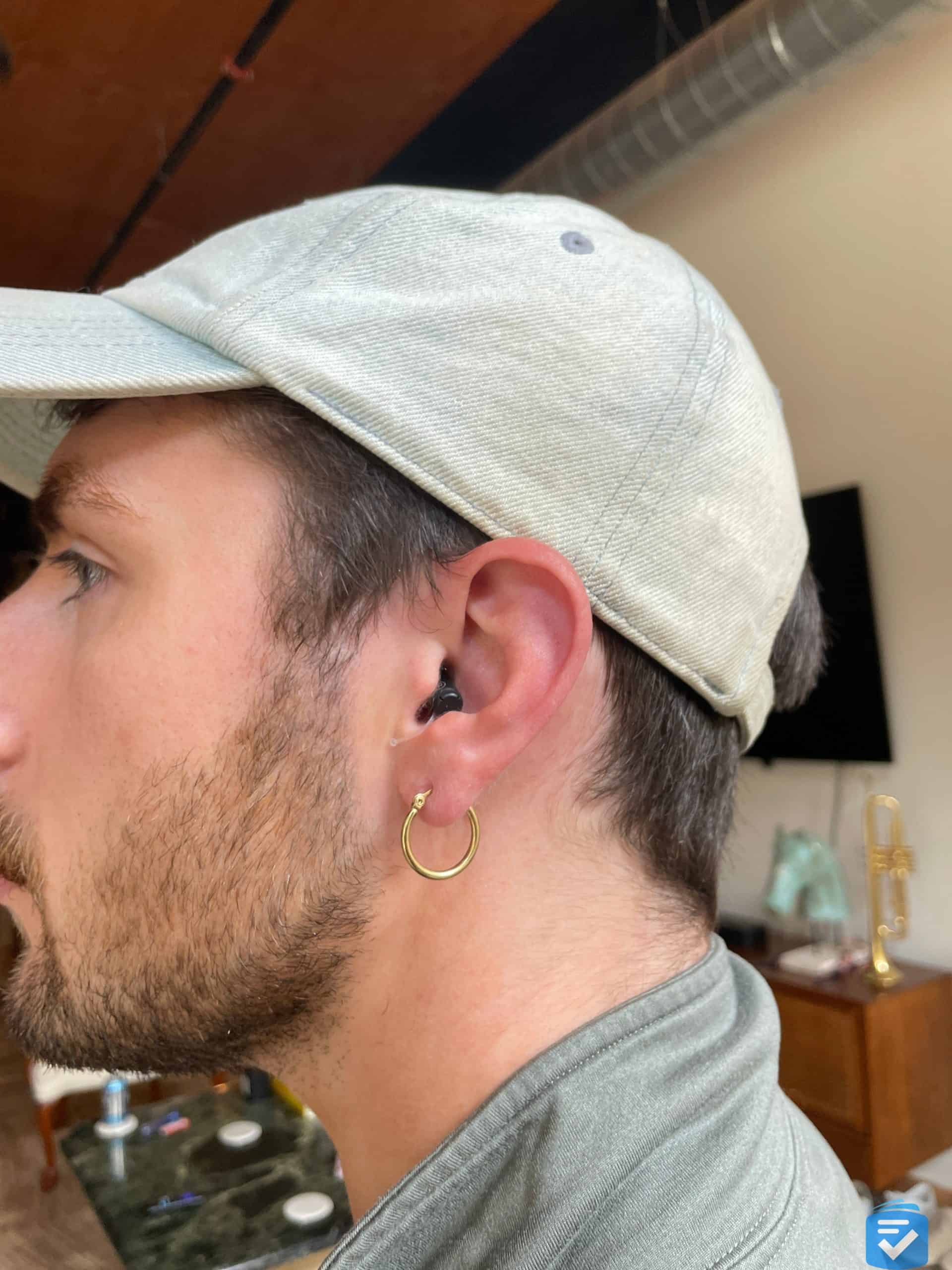
Eargo hearing aids are designed to be user-friendly. To insert our hearing aids, we picked up each device by the plastic removal thread, flipped them over, and gently inserted them into our ear canals. Each device is marked “R” and “L” for identification.
We found it easier to insert the devices by pulling gently on our earlobes with one hand and inserting the device with our other. The devices sat entirely inside our ear canals with the removal threads resting on our earlobes facing downwards. The removal thread is made of translucent plastic, so it can hardly be seen despite it hanging out of one’s ear.

To remove the device, you grasp the removal thread and gently pull it. The important thing with handling these devices is to treat them with care. They are delicate, so you don’t want to jam them in or out of your ear. Eargo devices work by pressure switches. So, if you want to change sound profiles anytime, you simply tap on your ear. The best method for us was using the flat of our hands to double-tap on our ear canals. You will know it worked when the device says the sound profile name, such as “program two.” In the factory settings, one is the lowest amplification, and four is the maximum.
For the Eargo 8, we could further personalize these sound profiles through the Eargo mobile app on Android and iOS. To do this, we placed the devices into the charger and connected the app to the hearing aids. Once we paired the devices, we could customize audio settings, check the battery life, and watch tutorials. We could even contact the Eargo help center for support from licensed hearing professionals.
The Eargo mobile app can adjust bass, treble, and personalize environment settings. Default audio environments include restaurants, crowds, theaters, and meetings.
We liked the TV setting, as we’ve had trouble understanding various programs clearly with other hearing aids. If you have specialized hearing needs outside these default environments, you can create presets for your left ear, right ear, or both. The devices must be in the charger to create and update personalized settings. The devices will remember these settings when you’re on the go.
Cleaning and Maintaining Your Eargo Hearing Aids
The process of cleaning and maintaining your Eargo hearing aids differs based on the model. While the Eargo 8 and the Eargo SE are both completely-in-canal, a similar design, you’ll clean the LINK by Eargo slightly differently, so we’ll start with that. To clean your LINK hearing aids:
- Clean the brush: Wash your cleaning brush in warm water and dish soap and let it air dry.
- Wash and replace your earpieces: You can either wash or completely replace your eartips if they’re broken, brittle, or torn. If they’re in good shape, remove the earpieces and soak them in warm water and dish soap, letting them air dry after scrubbing.
- Clean the exterior: Using a wipe of 70 percent isopropyl alcohol, wipe down the outside of the hearing aids.
- Clean the sound ports: Finally, you can clean the sound ports using the cleaning putty. Knead it into a ball, remove the ear tips, and press the putty into the sound outlet and inlet. Wipe down both hearing aids with the alcohol wipe to get rid of any remaining putty.
The process works similarly for the Eargo SE and Eargo 8, but after you’ve cleaned your brush, you may need to wash or replace the Trumpet tips the same way you would with the earpieces. Then, you’d clean the sound ports with the putty. Don’t forget to clean your charger with an alcohol wipe, as well!
Battery Life and Charging
All Eargo hearing aids feature rechargeable batteries, eliminating the need for disposable battery replacements. Additionally, each model has a portable charging case that doubles as storage when the devices aren’t in use. The charging case itself can store multiple charges, allowing you to recharge your hearing aids on the go without needing access to an electrical outlet. How many charges each charger holds, how long charging takes, and how long each charge lasts depends on the hearing aid model, detailed below.
| Hearing aid | LINK by Eargo | Eargo SE | Eargo 8 |
|---|---|---|---|
| Runtime in hours | 9 | 16 | 16 |
| How many charges the charger holds | 4 | 5 | 14 |
| How long charging takes | 1.5 | 3-4 | 2-4 |
We recommend placing your Eargo hearing aids in the charging case overnight. This ensures fully charged devices for the next day and protects them from dust and moisture. The charging case uses LED indicators to show the charging status of the hearing aids and the remaining power in the case itself.
One consideration worth noting is that, like all rechargeable devices, the batteries will gradually lose capacity over time. After approximately two to three years of regular use, you may notice a decrease in battery performance. Since the batteries cannot be replaced separately, you must purchase new devices once they no longer hold an adequate charge and your warranty has expired.
For those concerned about battery longevity, remember that certain features like Bluetooth streaming (available on the LINK) will drain the battery more quickly. During our testing, we found that streaming audio reduced battery life.
Eargo Warranty and Return Policy
Eargo provides a warranty on all hearing systems and their associated accessories. The LINK by Eargo, and Eargo SE devices have a one-year warranty, while the Eargo 8 has a two-year warranty.
If a device malfunctions, you may send the system back to Eargo, where specialists will inspect it and either repair it or provide a replacement. In-warranty repairs come at no extra charge.
The warranty does not cover devices in the following situations:
- Devices that have been abused, misused, or improperly handled or cared for, including exposed to chemicals
- Devices that have been immersed in water for prolonged periods of time (for the Eargo 8) or immersed in water at all (for the Eargo SE and the LINK)
- Devices that have earwax buildup due to poor maintenance
- Devices that have used parts or supplies that Eargo does not sell or authorize, etc.
While the warranty is active, Eargo will pay a portion to replace lost hearing aids. For the Eargo SE, you’ll be charged $295 per unit, and for the Eargo 8, you’ll be charged $395 per unit. This one-time loss coverage is not available on the Eargo Link.
Additionally, there is a 45-day, right-to-return period, so if you decide the system is not for you, you can return it for a full refund.
Is Eargo Worth It?
We loved the style and invisibility of Eargo’s hearing aids. They were extremely comfortable, and we hardly noticed them in our ears. The price is also hard to beat for the quality of the device. With that said, Eargo hearing aids aren’t meant for profound hearing loss. Are you among the millions of older adults with severe to profound hearing loss? If so, then a device from Signia or Oticon might suit you better.
Additionally, while rechargeable batteries are good for some lifestyles, some people prefer to use regular batteries. This way, they don’t have to deal with replacing a more expensive battery down the line.
We do want to emphasize the stellar customer support from Eargo. It’s a convenient and cost-effective alternative to an audiologist. Plus, Eargo employs licensed hearing professionals to answer technical support queries. Unlike some audiologists, the only downside is that they don’t offer in-person cleaning and maintenance for devices. However, Eargo makes up for this by offering a huge collection of user guides that will help you maintain your hearing aids independently.
All in all, the pricing and discounts help those in need realize that they are a viable and cost-effective option. For these reasons, Eargo is one of our picks for this year’s best hearing aids. But, if you want to explore other options, compare Eargo to some of the top providers:
How We Tested Eargo Hearing Aids
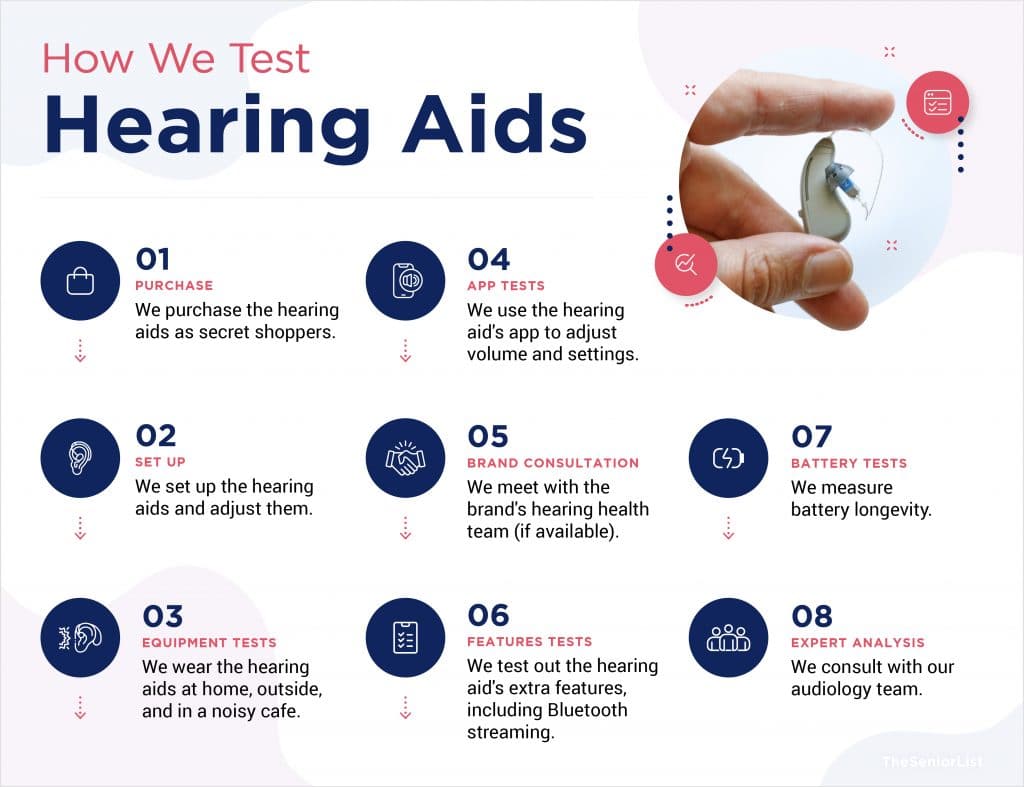
Eargo sells three models: the LINK by Eargo, Eargo SE, and Eargo 8. For the purposes of this review, we tested all three and evaluated each on the following criteria:
Style and fit: Our testing team wore Eargo hearing aids throughout the day and noted comfort and practicality.
Battery life: We tested the battery life on each of the three Eargo models.
Lifestyle: We wore each Eargo hearing aid in various environments—at home, outside, and in a crowded coffee shop—and evaluated how the devices performed.
Trials and warranties: We analyzed the cost of each pair, compared them to other devices, and examined the warranty policy.
Customer support: Eargo includes lifetime support from its team of hearing specialists. We conducted extensive calls with the support team to examine the quality of this service.
Frequently Asked Questions
-
Do I need a prescription for Eargo hearing aids?
Eargo hearing systems do not require a prescription or an audiologist exam. You can complete an online hearing screening and order them from your web browser or phone.
-
Does Medicare cover Eargo hearing aids?
Most Medicare plans do not cover hearing aids. However, some plans like Medicare Advantage Plans (Part C) offer expanded benefits, so be sure to check before purchasing a system.
-
How long does it take to charge my Eargo hearing aids?
The amount of time it takes to charge Eargo hearing aids depends on the model:
- LINK by Eargo: 1.5 hours
- Eargo SE: Three to four hours
- Eargo 8: Two to four hours
-
Will Eargo replace my hearing aids if they get wet or damaged?
Eargo will only replace your Eargo 8 hearing aids if they have been splashed by water and damaged or immersed in water for a short period of time, but not if they have been immersed in water for a prolonged period of time. For the Eargo SE and the LINK by Eargo, Eargo will not replace them if they’ve been immersed in water at all, only splashed. Additionally, replacements or repairs are only valid within the warranty periods, which is one year for the Eargo SE and LINK by Eargo and two years for the Eargo 8.
-
What kind of customer support does Eargo offer?
Eargo offers stellar lifetime technical and customer support, including an initial call with a hearing specialist to discern your hearing needs. Eargo employs audiologists and support technicians to respond to any query. These agents can even make remote programming adjustments to your hearing aids. In addition, Eargo offers phone support weekdays from 8 a.m. through 8 p.m. and Saturdays from 8 a.m. to 5 p.m., Central Standard Time. There is also live chat and an online support center.

